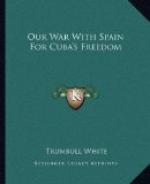The natural resources of the Philippines are very good, and under a civilized administration these islands would be rich and prosperous, But the mildew of Spanish misgovernment is upon everything and its perennial blight is far more disastrous than the worst outbreaks of savagery in time of war. His total inability to maintain an endurable government in time of peace is what marks the Spaniard as hopelessly unfit to rule.
Manila has cable connection with the rest of the world, and regular lines of passenger steamers. The European colony has its daily papers, which are, however, under strict censorship, religious and military, and keeps up with the news and the fashions of the day. Until the insurrection of the last two years, the army, except two Spanish brigades of artillery and a corps of engineers, was composed of natives and consisted of seven regiments of infantry and one of cavalry. There was also a body of Spanish militia in Manila, a volunteer corps similar to the one which was always maintained in Havana under Spanish rule, which could be called out by the captain-general in the event of need.
Spain’s feeble control of the islands.
When the latest insurrection began, Spain shipped to its far-off colony all the men who could be spared from service in Cuba, and after a few months of fighting it was announced that the rebellion was crushed. As a matter of fact, however, Spain has control of but a comparatively small part of the islands, and the natives elsewhere are as free from obligation to pay Spanish taxes as they were before the discovery.
Trade restrictions have hampered the commercial progress of the colony, but in spite of that fact their trade with the outside world is a large one. For many years after the conquest but one vessel a year was permitted to ply between Manila and the Spanish-American port of Acapulco. Then the number was increased to five. Then a Spanish chartered company was given a monopoly of the trade of the islands. When that monopoly expired, other houses began business, until finally many large English and German firms shared the trade, while American houses and American ships were by no means at the foot of the list. The total volume of the exports and imports is about $75,000,000 annually.
The manufactures of the Philippines consist chiefly of textile fabrics of pineapple fiber, silk and cotton; hats, mats, baskets, rope, furniture, pottery and musical instruments. Vegetable products of great value are indigo, cocoa, sugar, rice, bamboo, hemp and tobacco. Coffee, pepper and cassia grow wild in sufficient quantity and quality to provide a living for those who wish to take advantage of what nature has provided. Coal, gold, iron and copper are mined with profit. The soil is exceedingly fertile, and although the climate is tropical, with little change except between wet and dry seasons, it has not been




